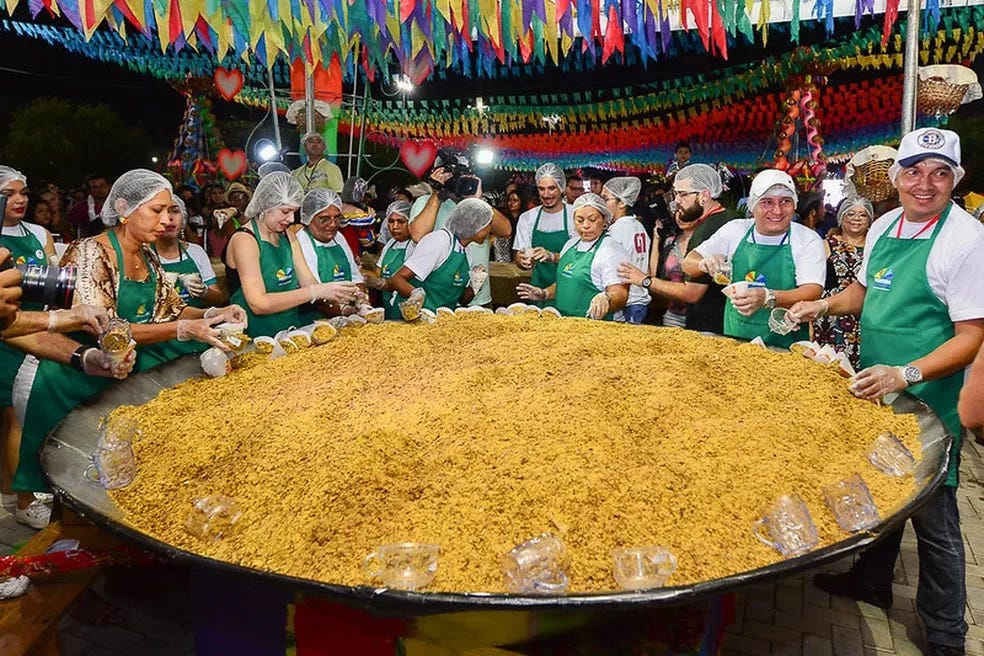Bigger than Carnaval: Northeastern Brazil Celebrates St. John's Month
Brought by Portuguese colonists in the 1500s, the once-pagan Midsummer festival has evolved into an Afro-Indigenous-Catholic fusion of music, dance, theater, and food that attracts millions
In the Catholic tradition, St. John's day falls on the summer solstice. The first mention of the lighting of bonfires on that day in western writing appears at the hand of Jean Belethus in the 12th century in reference to St. John, but many historians believe that it was a Catholic appropriation of an earlier pagan tradition which could possibly date back to neolithic times.
The Portuguese first brought the Catholicized pagan tradition of St. John to the Brazilian northeast in the 1500s. Since they were now in the Southern Hemisphere, St. John's day no longer coincided with the summer solstice. As in other places where the Catholic church arrived hand in hand with bloodthirsty imperial colonists, its local bureaucrats took the route of least resistance. Instead of going through all of the bureaucracy and bloodshed of fighting to eradicate "pagan" traditions like protestants, the local bishops issued and stamped a few proclamations proclaiming that the indigenous first peoples' annual June maize harvest festival would now be held to honor St. Anthony, St. John and St. Peter. To the feasts, music and dancing that were already going on, the Catholics added a few masses, and the tradition of the giant bonfire - which made sense anyway on those cool winter nights up on the escarpment in the agreste and sertão, where temperatures sometimes dropped to 10 degrees Celsius at that time of year. Instead of merely outlawing the whole thing, as some tightassed American pilgrims might have tried to do, St. John's month was now an umbrella festival, in which all kinds of music, dance, theater and poetry were welcome, as long as the Catholic saints were remembered now and again.
With these came a tidal wave of mythology and folklore from Africa, like the Bumba Meu Boi, a theater, music and dance piece that can last for hours, interpreted in different ways across the northeast, involving an enslaved farmer who cuts out the tongue of a prize bull for his pregnant wife, who has a craving. The bull dies, folkloric gunmen dance in, but the bull miraculously comes back to life and everyone is spared. To the Yoruba people from West Africa who were imprisoned and sold into forced labor in Brazil during the early 1800s, St. John’s day became the traditional day of worship of Xango, the God of thunder, and one more element of multiculturalism was incorporated into the celebration.
Other St. John's customs came later, like Bacamarte, a tradition which was started by drafted soldiers returning from the bloody Paraguayan war in 1870. Bacamarte is the Portuguese word for blunderbuss. Battalions, dressed like Victorian age soldiers or 1930s back country outlaws, dance down the streets, accompanied by their own three-piece baião orchestras - an accordion, a hide-bound hand drum of West African origin called a zabumba and a triangle. Meeting up with other Bacamarte groups, they dance in and out of the St. John's crowds until, at a certain moment, they head off to the side where they won't cause so much ear damage, and take turns ramming their blunderbusses full of powder (with no musket balls) and blowing them off, one by one.
Throughout the different dances and theater pieces going on, including the heavily stylized country wedding dance performances called Quadrilha, there are main acts with nationally famous musicians playing forró, dance pavilions, carnivals, puppet theaters and outdoor bars and restaurants where families eat and drink together all night long, to the cacophony of kids blowing off firecrackers and M-80s.
St. John’s Day in Caruaru: the video
I shot the following news story for From the South on St. John's day in Caruaru, Pernambuco, a city with a population of around 500,000 located 1500 feet above sea level in the agreste. This year the mayor's office estimates that 3 million tourists visited the city for this year's São João festivals. After the video, I’ll reprint the transcript.
Narrator: Brazil may be famous for its carnaval, but in large swathes of the country, particularly in the Northeast, The June festivals, centered around St. Anthony, St. John and St. Peter, are more popular. Originally brought to Brazil by Portuguese colonizers in the 1500s, over the centuries the festivals have been infused with African and indigenous folklore , leading to a social phenomenon which is uniquely Brazilian.
José Urbano Silva - Historian:
Portuguese Catholic religious myths, the indigenous celebration of the corn harvest and African drums and musical traditions have merged, laying the foundation of this great celebration - the biggest and best St. John's Festival in the world, here in Carauru, Pernambuco.
Narrator: Every year, in northeastern back country, Campina Grande and Caruaru vie for the title of Brazil's largest St. John's festival, by hosting free shows with nationally popular musical acts. This year the Caruaru Mayors' Office announced that 3 million tourist have already visited the city, but to many, the most important thing about St. John's is preserving local history and culture.
Jose Nelson Lima - Actor:
Caruaru's June Festivals are important because they don't just focus on music, drinking and eating, but on folklore in general. So in addition to those things, there's theater, a circus, poetry and dance.
Narrator: Many of the traditional St. Johns dances, like Quadrilha, a stylized, country wedding dance, serve a social function, strengthening local communities by bringing young people together to in their neighborhoods for regular practice sessions for months before the June parties start off.
Lucineia Chagas - Director of Molecodrilha Quadrilha Group:
We spend the whole year practicing, it's a kind of social work too because we are working with poor children and adolescents. It's a way to motivate this gets to stop doing wrong things on the street and focus popular culture, where they encounter a completely different world from where they come from so it's very satisfying for me to do this with them
Narrator: St. John's festival traditionally ends on St. Peters day on June 29th, but, more and more, local government are spilling the parties into July.
Brian Mier, teleSur, Caruaru






I notice you omitted that it celebrates the curing of Saint John's Wart.